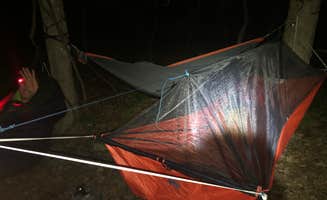Dispersed camping near West Nyack, New York provides opportunities for backcountry camping in forested terrain. The area sits at elevations ranging from 500-900 feet with predominantly deciduous forest cover, offering seasonal color changes. Weather conditions vary significantly throughout the year, with summer humidity requiring proper preparation for those seeking primitive camping experiences near the Hudson Valley.
What to do
Trail exploration: At Taconic Hereford Multiple Use Park, hikers can access extensive trail networks that connect to additional protected forest lands. According to camper Doc B., "There is plenty of trails to explore and wildlife to enjoy, especially since these over 900 acres also back up to another huge plot of protected forests."
Climbing access: Many visitors use primitive camping near West Nyack as a base for rock climbing excursions. Cory D. notes that at Hemlock Ridge MUA Dispersed, "Many climbers stay there for access to the gunks," making it a practical option for those heading to popular climbing areas.
Wildlife observation: The natural forests provide habitat for various wildlife species. Forest birds, small mammals, and seasonal wildflowers can be observed throughout the area, particularly during morning and evening hours when animal activity increases.
What campers like
Solitude and tranquility: Dawn M. appreciates Hemlock Ridge MUA for its peaceful setting, stating, "I was the only one here and it was a very peaceful and relaxing night." The limited parking capacity naturally restricts visitor numbers, enhancing the sense of isolation.
Proximity to civilization with wilderness feel: Despite being relatively close to populated areas, these camping locations maintain a remote atmosphere. According to Doc B., Taconic Hereford Multiple Use Park is "Less then 10 min drive from town, but hiking in and finding a suitable place to make camp has the feeling of the wild, with the safety of having full cell service."
Budget-friendly accommodations: Free dispersed camping options provide economical alternatives to developed campgrounds. One camper at Taconic Hereford noted that even when fees apply, rates remain reasonable at "only $25 night" with "Great looking facilities and friendly staff."
What you should know
Limited amenities: Primitive camping sites in this region provide minimal facilities. Dawn M. describes Hemlock Ridge MUA: "There are absolutely no amenities whatsoever and barely even a signal here." Campers must bring all necessary supplies including water, food, and waste disposal containers.
Parking constraints: Vehicle access presents challenges at some locations. At Hemlock Ridge, "The parking lot only holds about 4-5 cars, 6 if you park real tight," according to Dawn M., requiring weekday or early arrival during peak seasons.
Environmental responsibility: Leave No Trace principles apply throughout these areas. Doc B. emphasizes the importance of responsible use, advising visitors to "Please enjoy Mother Nature's healing love, and leave the area cleaner than when you arrived."
Tips for camping with families
Safety communication: When bringing children to remote camping areas, establish clear safety protocols. Doc B. recommends, "Always let someone know where you are headed and when you plan to return," which becomes especially important when camping with family members.
Insect protection: Prepare for seasonal bug activity that can affect comfort levels. According to Cory D., at Hemlock Ridge, "Bugs are relentless," making proper insect repellent and protective clothing essential for family camping trips, particularly during spring and summer months.
Navigation tools: Floyd Bennett Field and other dispersed camping areas may have unmarked or minimally marked trails. Families should bring paper maps, compass, or GPS devices that function without cellular service to navigate safely with children.
Tips from RVers
Alternative accommodations: Most dispersed camping areas near West Nyack accommodate tent camping only, with limited or no facilities for recreational vehicles. RV travelers should research developed campgrounds with appropriate hookups before arrival.
Day-use options: Consider using dispersed camping areas for daytime activities while staying at developed campgrounds. This approach allows access to natural areas while maintaining RV amenities like electricity and water hookups at night.
Access limitations: Vehicle size restrictions make most primitive camping sites unsuitable for larger RVs and trailers. Narrow access roads, limited parking, and absence of designated parking pads create challenges for vehicles beyond standard passenger cars.



